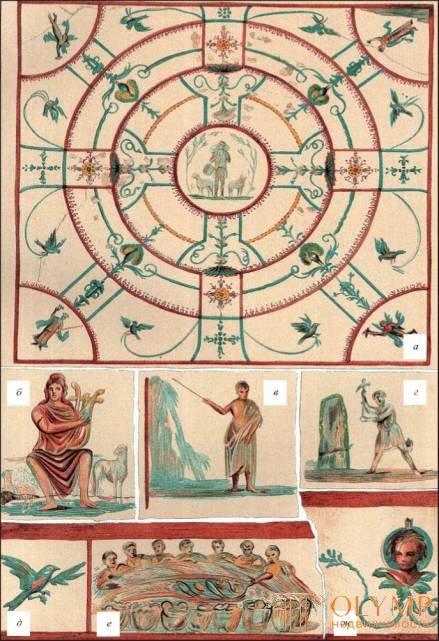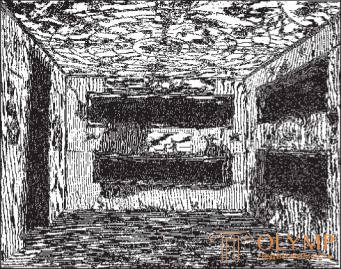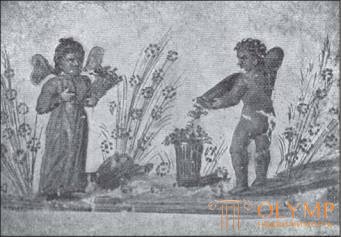
The painting of the first centuries of Christianity keeps us in the catacombs; of all the plastic arts, it was she who, in the ceiling and wall paintings of the burial chambers, achieved the greatest brilliance, and it was in catacomb painting that for the first time Christian art spread its wings for independent flight.
We owe our acquaintance with catacomb painting primarily to the studies of J. B. de Rossi, L. Perret, T. Roller, Ios. Vilperta, F.-Ks. Kraus, Victor Schulze, Yog. Fichera, O. Marukki, Ios. Fuhrer and their predecessors. Then, along with special works regarding this painting by researchers such as Ezh. Münz, L. Lefort, O. Paul, Hell. Gazenklever, A. de Val, Edg. Genneke and Wilpert (his major essay is Catacomb Paintings of Rome), monographs should be written on almost every single subject of ancient Christian art, and the authors' differences on one issue or another are partly due to their belonging to different religions.
From an artistic point of view, the Roman catacomb paintings, best studied, belong to the type of hand-crafted Roman-Hellenistic grave frescoes. As in the pagan wall painting of the Etruro and Roman hypogues, they, with a few exceptions, are dominated by a white background, due, however, to the weak illumination of the catacombs. This background is always made alfresco, that is, it is induced on a still wet layer of lime plaster, the images themselves are written in part also alfresco, partly on dried plaster. Although in places there are whole small landscapes of an idyllic character and often elements of the landscape are part of one or another scene, this last one does not have a solid background at all. But the catacomb images of this era have not yet returned to the black contours; the figures are delineated quite softly and naturally, and the more ancient images compare favorably with the later ones with a more correct pattern and a greater freshness of tones.
At the heart of the pictorial ornamentation of square ceilings of cubicles (as well as pagan ceiling painting of the same time) is usually the division of the ceiling into fields proceeding from a circular central field, this division inscribes the outer circle or octagon into an equilateral quadrilateral and then diagonally divides the entire area into segments of various shapes (Fig. 3, a). Borders of fields are often marked only with red or blue stripes, but often these are also seated with hooks, crosses, triangles, teeth, bows, or turned into Ionic pearl cords. The favorite Greek motifs of the linear ornament, a number of waves and meander incident on one another are rarely found, but the more often instead of simple lines or between them are the antennae of plants, leafy branches, vine shoots, flowers on stalks, garlands and flower vases; Acanthus leaves are usually depicted at the base of deciduous petioles and flower shoots.

Fig. 3. Painting in the catacombs of St. Kalliksta in Rome: a is the ceiling in the second chapel of the Holy Mysteries; b - Orpheus, on the ceiling, “Cubicolo dell 'Orfeo”; c - Moses; d - grave digger (Fossor); d - pigeon; e - the meal of seven; g - a mask from the second chapel of the Holy Sacraments. By de Rossi
Game: Perform tasks and rest cool.8 people play!
Play gameMany of the catacomb frescoes testify to the ability of Christian painters to transmit separate religious ideas in simple but understandable and touching images and to reproduce biblical and evangelical events.
Game: Perform tasks and rest cool.8 people play!
Play game
Fig. 4. One of the chapels of Cemetheus Callixtus in Rome. By de Rossi

Fig. 5. Psyche. Fresco crypt of sv. Nerey in the catacomb of Domitilla in Rome. From the photo
In artistic terms, first of all, the decorative unity of this painting, achieved by strictly symmetrical matching of its elements to each other, draws attention to itself. The mistake of some researchers, such as Springer, was to recognize this symmetry only in the ceiling painting of individual cameras. As for the content of these frescoes, it should be noted that here, as in other catacombs, purely decorative, symbolic, household and historical images are linked into one whole, reflecting the faith of Christians in the Atonement.
All images of this kind we find in the remaining Roman catacombs. The decorative cycle includes, for example, antique murals of the crypt of St. Yanuariya in the catacomb Pretext, with images of the seasons, personified figures of children collecting roses, ears, grapes and olives, or the fresco of the crypt of St.. Nereus is in the catacomb of Domitilla, where Psyche in long clothes vomits flowers (Fig. 5). On the contrary, in the circle of Christian ideas, the image of the legendary pagan singer Orpheus takes on a completely symbolic character. In the catacomb of Domitilla, on one acre, he is represented sitting among wild animals and taming them with the lyre, and on the ceiling of one of the chambers of the Callacst's catacomb, he is surrounded by lambs and, thus, approaches the type of the Good Shepherd (see. Fig. 3, b). Orpheus owes his appearance in ancient Christian art partly to the miraculous power of his lyre, partly to the idea of immortality, which Orphic sacraments were imbued with. However, already in the III century it disappears from the plots of catacomb painting.
Realistic images, in addition to so frequent fossors (see Fig. 3, d), are primarily portraits of the dead. But in these images the phenomena of reality are easily combined with symbolism. On the large mural of the “crypt of the five saints” in the catacomb of Callixte five male and female figures, whose names are marked with inscriptions, are depicted standing with prayer-upraised hands among the blooming paradise garden; similarly, “family meals”, which in their content can often be compared with pagan memorial dinners (cf. the frescoes of the Villa Pamphili, see v. 1), in some cases, such as, for example, in the so-called Greek chapel of the Priscilla catacomb, presenting fraternal meals (agaps), hint at the Last Supper or even the mystical heavenly feasts of the righteous.

Game: Perform tasks and rest cool.8 people play!
Play gameThe following are the main images of the Christian cycle. God’s Father Himself in this epoch is not depicted yet, but His hand is often depicted coming from the clouds, as, for example, in the scene of Isaac's sacrifice in Ostrian cemetria or in the composition “Moses receiving the commandments” in the catacomb of St. Peter and Marcellinus. As for the image of the Savior, it appears already in the early catacomb painting, sometimes in the form of the Infant on the lap of the Mother of God, as, for example, in the beautiful fresco of the Priscilla catacomb (Fig. 6), sometimes in the form of a young man, as in the Baptism scene in the crypt of Lucina, sometimes still in youthful and beardless type, in the form of a miracle worker, for example, in the scene of the Resurrection of Lazarus in the last of the chapels of the Holy Mysteries; finally, by the end of this epoch, Christ appears as the Master among His disciples, for example, in the fresco of Ostrian cemetria. The earliest extant images of the Blessed Virgin are the above-mentioned murals in the Priscilla catacomb: Our Lady with Roman traits sits half-way to the left; Baby takes her breast. A star is depicted above it, and in front of it stands, pointing to a star, a beardless man, whom we, along with Kraus and Wilpert, recognize as prophet Isaiah (see Prince Isaiah Ave., VII, IX, Matt. I, 23) . This is a serious, calm, heart-telling scene in which, so to speak, all the future Madonnas are apprehended. Almost at the same time, the Most Holy Virgin appeared on the ceiling fresco of the same catacomb, but without the Child, sitting on a throne, in front of which stands a young angel-evangelist, perhaps the most ancient of the angels of Christian art that have come down to us. Throughout the pre-Constantine era, angels are depicted, as in the above example, in the form of wingless youths dressed in a tunic and cloak. In the form of winged youths they appear, adjoining the Hellenistic images of victories, first in the art of the Christian East, but also here only after the victory of Christianity over paganism.
Most of the Roman catacomb frescoes depict biblical events, and the Old Testament scenes are reproduced more often than the New Testament, with the exception of the Good Shepherd, and perhaps not just a coincidence that the oldest surviving Roman catacomb paintings, namely the Flavius gallery frescoes in the catacomb of Domitillus (Imititella) besides small decorative landscapes, a vine with winged children's figures and symbolic images of the Good Shepherd and a memorial meal, they contain only two Old Testament scenes: “But th in the ark "and" Daniel in the den of a lion. " Daniel is usually depicted naked, en face, between two lions in a heraldic style. Three youths in the fiery furnace have Phrygian caps on their heads and stand in the pose of orants among the flames. Noah, to whom the dove carries the olive branch, swims on the waves alone, in a small box (cf. with antique vase images of Danae, thrown into the sea).
Game: Perform tasks and rest cool.8 people play!
Play gameIn all the catacomb frescoes, the depicted action is played out with the least possible number of figures, extremely simply and calmly. Since the same subjects were interpreted approximately equally in all, including in the Roman Catholic Christian catacombs, it must be assumed that some painters-decorators of the cubicles did not assemble the images themselves, but adhered to the samples developed by collective creativity. Be that as it may, this alien external effects painting came out of the heart and speaks primarily to the heart.
К древнехристианской живописи можно отнести также изображения на золоченых стеклянных сосудах. От большинства этих сосудов сохранились лишь двойные донышки и между двумя их пластинками заключен тонкий золотой листок, в котором выскоблен рисунок, иногда оживленный раскраской. Хотя родина подобных золоченых сосудов, как надо полагать, Восток, однако большая их часть найдена в римских катакомбах. Самые древние из таких сосудов мифологическими и реалистическими сюжетами своих изображений свидетельствуют о своей принадлежности языческому времени. Из сосудов доконстантиновской эпохи, отличающихся тонкостью рисунка и шрафировки, всего один, принадлежащий Ватиканской библиотеке, украшен, несомненно, христианским изображением, и это последнее — опять-таки Добрый Пастырь. В этих произведениях древнехристианского искусства, как и во всех прочих, символические изображения предшествуют историческим, библейским сюжетам.
Что бы оставить комментарий войдите
Комментарии (0)